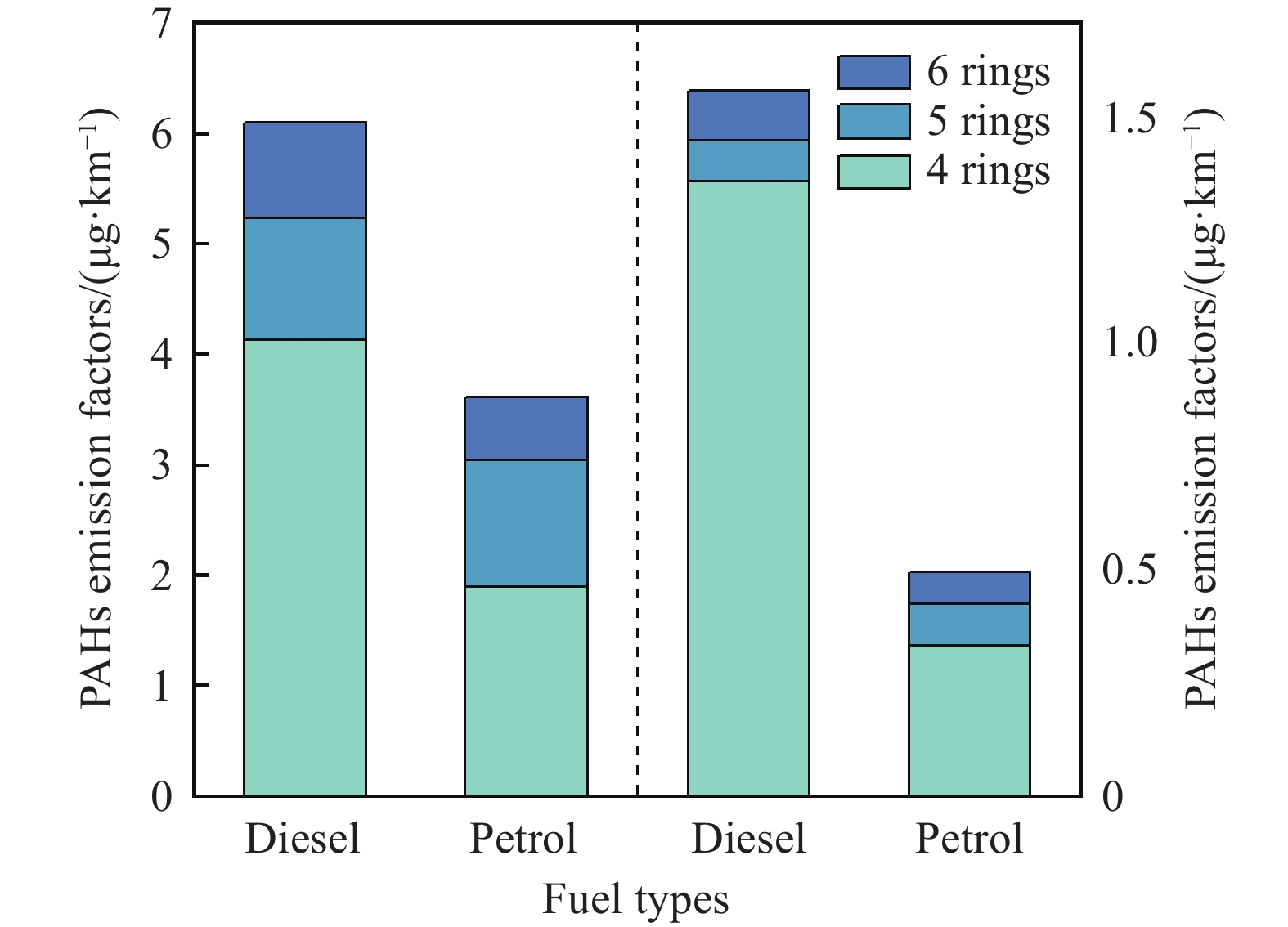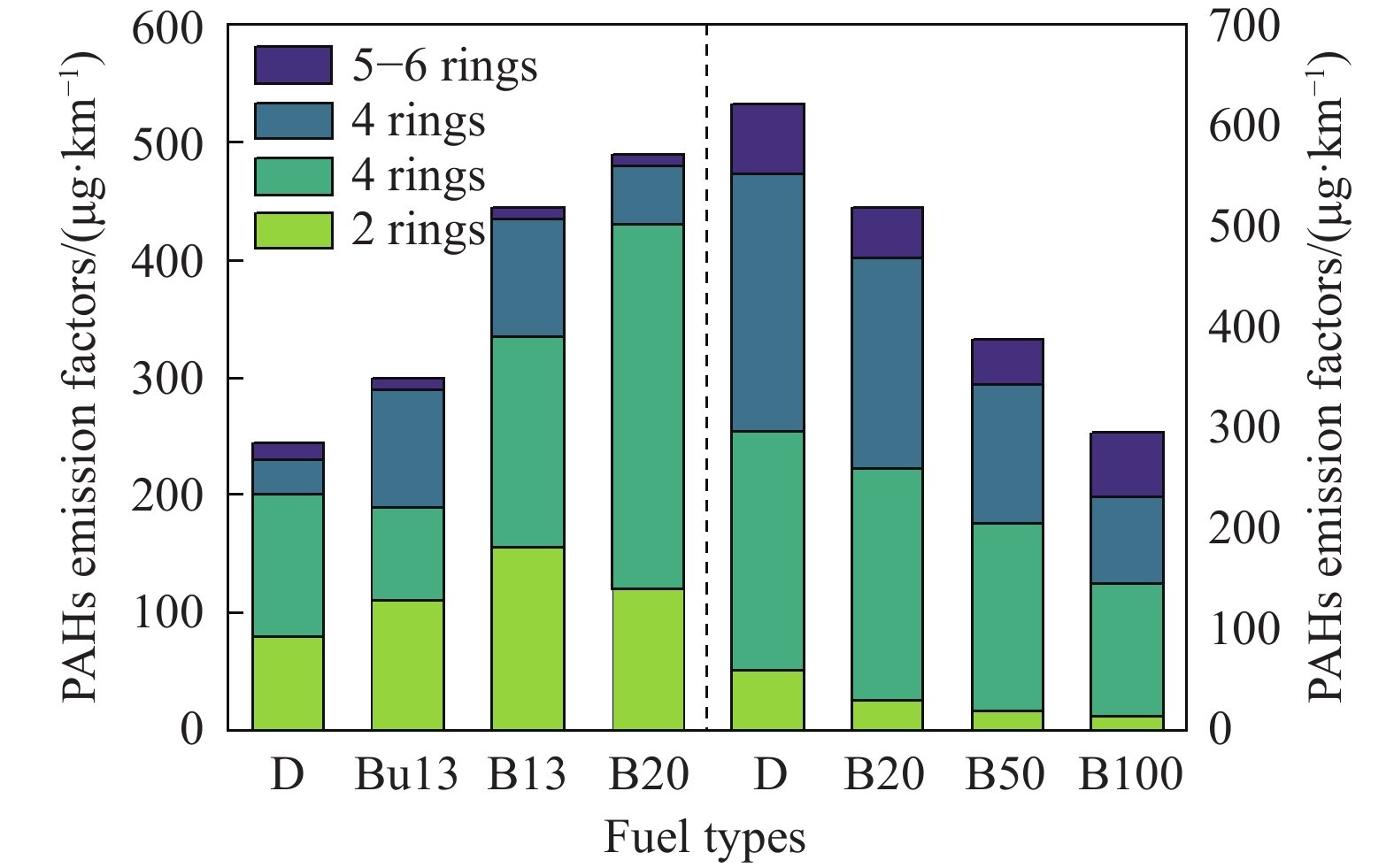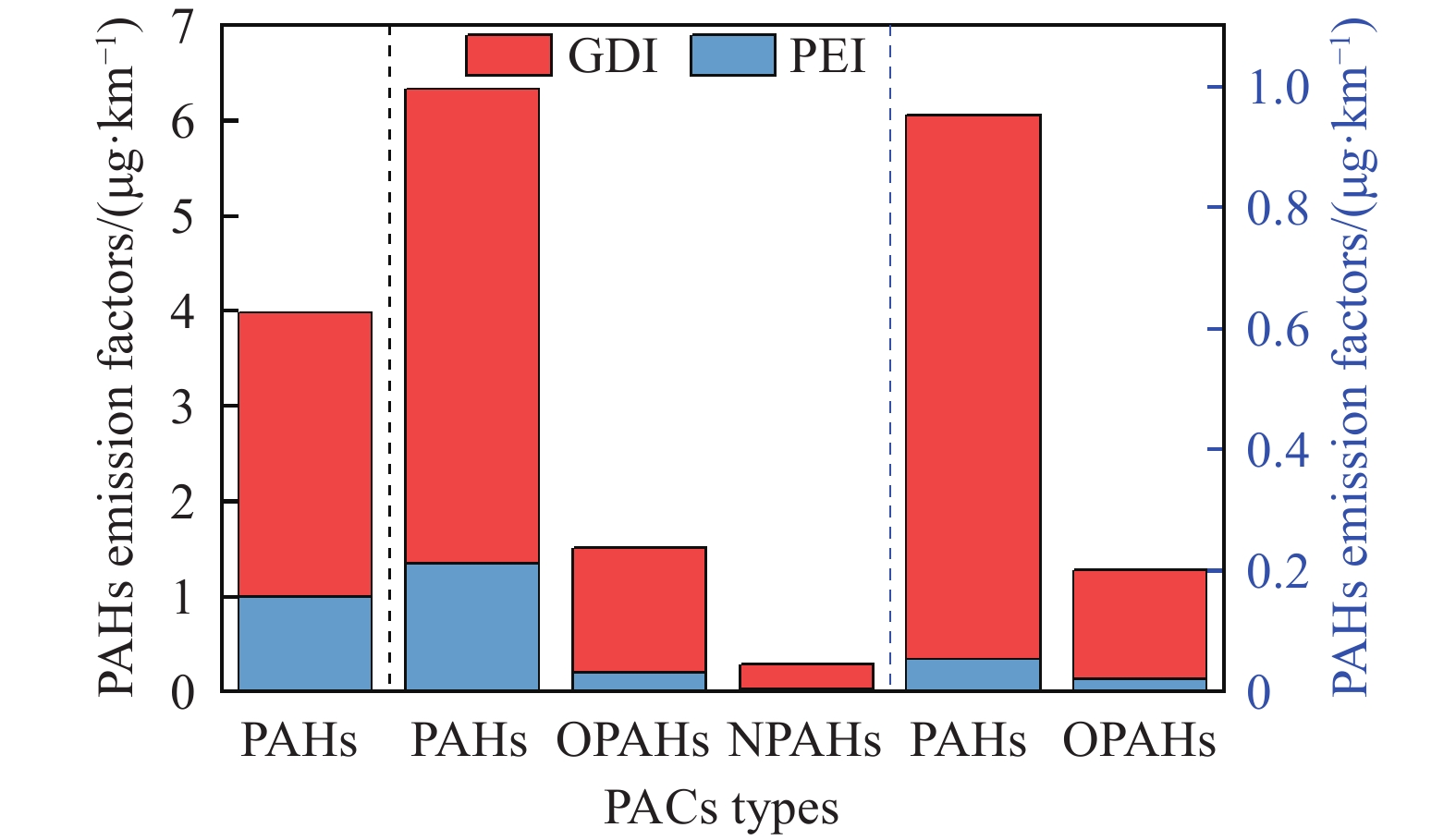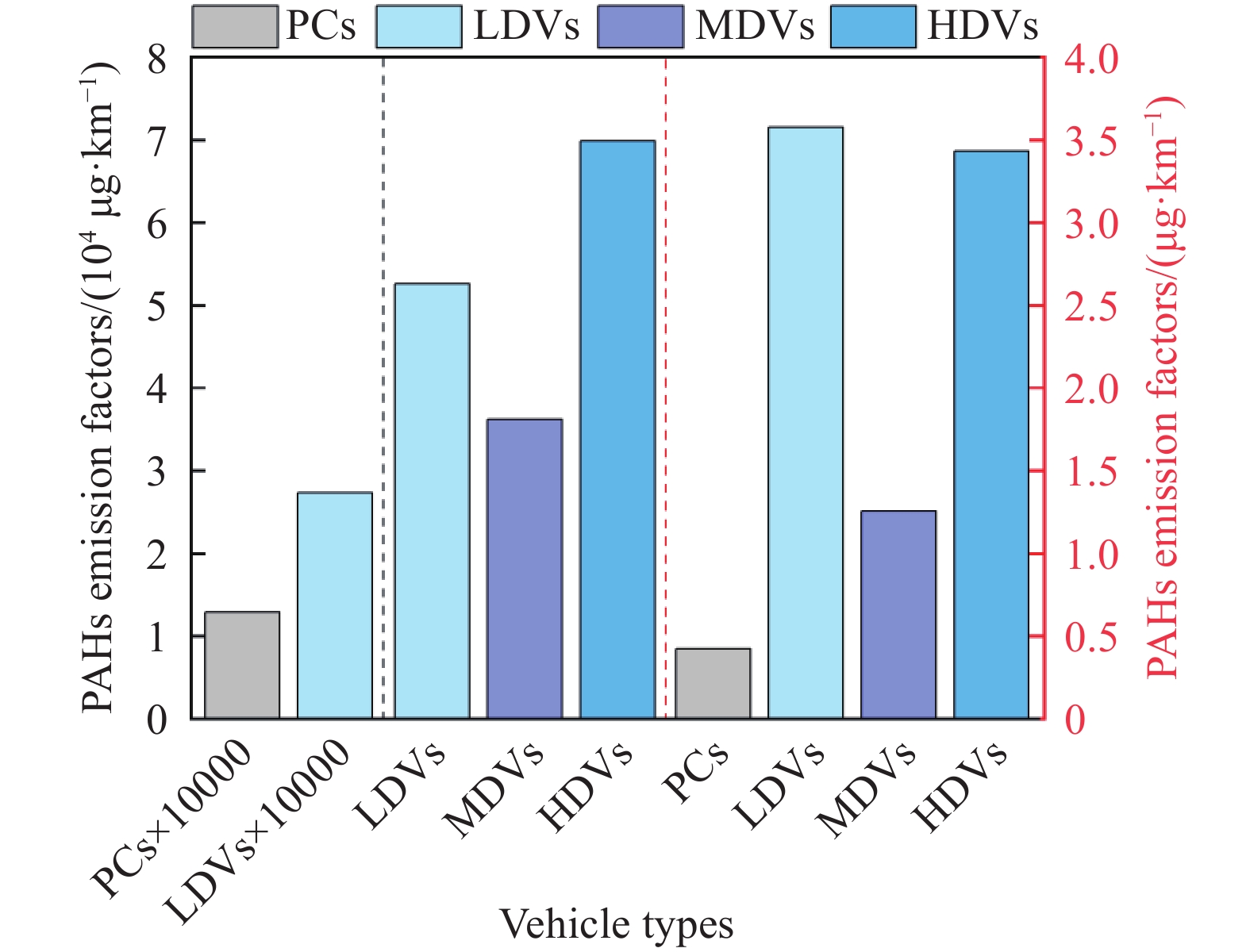Research progress on the influencing factors of polycyclic aromatic hydrocarbons and derivatives from vehicle exhaust and non-exhaust emissions
-
摘要: 機動車尾氣排放多環芳烴(PAHs)及其衍生物主要源于化石燃料的不完全燃燒,排放特征隨燃燒條件和燃料種類變化而有所不同.隨著尾氣排放控制標準日益嚴格和新能源汽車的逐漸普及,非尾氣排放污染對交通大氣污染的貢獻逐年加大.因此,包括剎車磨損、輪胎磨損、道路揚塵再懸浮和路面磨損在內的非尾氣排放過程作為城市環境PAHs的重要污染源,其占比不容忽視。機動車來源PAHs及其衍生物的排放特征主要受燃燒條件、路面條件和機動車部件材料種類等多種因素影響。本文對國內外現有的機動車尾氣排放以及非尾氣排放PAHs及其衍生物的數據進行了梳理和總結。總的來說,對于尾氣排放,嚴格的排放標準導致PAHs及其衍生物排放量降低;冷啟動、加速等工況下,發動機燃燒效率降低,排放量增大;柴油車排放量遠高于汽油車;汽油直噴發動機比氣道噴射發動機排放更高;車輛行駛里程增加排放量增加。且研究發現剎車片化學成分、制動情況、輪胎材料和路面條件等均會影響排放,具有高度的不確定性,有待進一步研究。本文旨在分析機動車來源PAHs及其衍生物在不同影響因素下的排放特征,為排放控制技術發展和政策標準制定提供科學依據。Abstract: Polycyclic aromatic hydrocarbons (PAHs) are a group of toxic organic compounds from vehicle emissions. Many PAHs are carcinogenic, teratogenic, mutagenic, and immunotoxic, causing a negative impact on human health and severe damage to the environment and ecosystems. Although PAH derivatives, including nitro-polycyclic aromatic hydrocarbons (NPAHs) and oxygenated polycyclic aromatic hydrocarbons (OPAHs), are one to three orders of magnitude lower in concentration than PAH parents, some components are far more mutagenic and carcinogenic than PAH parents. The PAHs and their derivatives in motor vehicle exhaust emission are mainly caused by the incomplete combustion of fossil fuels, and their emission characteristics vary with the combustion conditions and fuel compositions. With the increasingly strict control of exhaust emission standards and the gradual popularization of electric vehicles, non-exhaust emissions have become the main contributors to traffic air pollution. Therefore, as the main source of PAHs in an urban environment, non-exhaust emissions, including brake wear, tire wear, road dust resuspension, and road wear emissions, cannot be ignored in terms of their contribution proportion. The emission characteristics of PAHs and their derivatives from vehicles are mainly affected by many factors, such as combustion conditions, road conditions, and the types of motor vehicle parts and materials. This paper collates and summarizes the existing data on vehicle exhaust and non-exhaust emissions of PAHs and their derivatives at home and abroad. In general, for exhaust emission, stricter emission standards lead to lower emission of PAHs and their derivatives; under operating modes, including cold start and acceleration, the engine combustion efficiency is reduced, leading to an increase in emission; the emission of diesel vehicles is much higher than that of gasoline vehicles; gasoline direct injection (GDI) exhibits higher PAH emissions than port fuel injection (PFI); and emissions increase with increasing vehicle mileage. At present, studies on the non-exhaust emission of PAHs and their derivatives are lacking. Existing studies find that the chemical composition of brake pads, braking conditions, tire materials, and pavement conditions affect non-exhaust emissions, but these findings have a high degree of uncertainty and need further research. This paper is intended to analyze the emission characteristics of PAHs and their derivatives from motor vehicles under different influence factors to provide a scientific basis for developing emission control technology and formulating policy standards.
-
Key words:
- vehicle emission /
- PAHs /
- NPAHs /
- OPAHs /
- vehicle exhaust /
- non-exhaust emission
-
圖 2 不同可再生燃料/柴油混合比PAHs的環數分布及總PAHs排放因子[16–17]
Figure 2. Distribution of different PAHs rings and emission factors reported in the literature with diesel, biodiesel and biodiesel/n-butanol blends[16–17]
Notes: D—Diesel; Bu13—The volume fraction of 13% butanol blending with diesel; B13, B20, and B50—The volume fraction of 13%, 20%, and 50% biodiesel blending with diesel, respectively; B100—Biodiesel
表 1 不同排放標準下PAHs的環數分布及總PAHs排放因子[5,8,10]
Table 1. Distribution of different PAHs rings and emission factors reported in the literature under different emission standards[5,8,10]
Test cycles WLTC, Gasoline CHTC-HT, Diesel ARTEMIS Urban, Gasoline Emission standards China Ⅲ China Ⅳ China Ⅴ China Ⅲ China Ⅳ China Ⅲ China Ⅳ China Ⅴ PAHs at 2?3 rings 4.2% 4.3% 4.4% 80.3% 100.0% 99.5% 100.0% 100.0% PAHs at 4 rings 27.3% 25.7% 25.1% 19.7% BDL 0.5% BDL BDL PAHs at 5 rings 44.9% 44.4% 45.2% BDL BDL BDL BDL BDL PAHs at 6 rings 23.6% 25.6% 25.3% BDL BDL BDL BDL BDL ΣPAHs emission factors/(μg·km?1) 924.655 794.395 744.645 7.1 2.6 225.651 40.502 0.388 Notes: WLTC—Worldwide harmonised light-duty vehicles test cycle; CHTC-HT—China heavy-duty commercial vehicle test cycle for heavy trucks; ARTEMIS Urban—Urban Artemis driving cycle; BDL—Below detection limit. www.77susu.com<span id="fpn9h"><noframes id="fpn9h"><span id="fpn9h"></span> <span id="fpn9h"><noframes id="fpn9h"> <th id="fpn9h"></th> <strike id="fpn9h"><noframes id="fpn9h"><strike id="fpn9h"></strike> <th id="fpn9h"><noframes id="fpn9h"> <span id="fpn9h"><video id="fpn9h"></video></span> <ruby id="fpn9h"></ruby> <strike id="fpn9h"><noframes id="fpn9h"><span id="fpn9h"></span> -
參考文獻
[1] Patel A B, Shaikh S, Jain K R, et al. Polycyclic aromatic hydrocarbons: Sources, toxicity, and remediation approaches. Front Microbiol, 2020, 11: 562813 doi: 10.3389/fmicb.2020.562813 [2] Bandowe B A M, Meusel H. Nitrated polycyclic aromatic hydrocarbons (nitro-PAHs) in the environment-A review. Sci Total Environ, 2017, 581-582: 237 doi: 10.1016/j.scitotenv.2016.12.115 [3] Xu Y Z, Zhang J, Yuan L M, et al. Sewage treatment based on plasma technology. Res Explor Lab, 2021, 40(4): 66 doi: 10.19927/j.cnki.syyt.2021.04.016許允之, 章金, 袁麗梅, 等. 基于等離子體技術的污水處理. 實驗室研究與探索, 2021, 40(4):66 doi: 10.19927/j.cnki.syyt.2021.04.016 [4] Hooftman N, Messagie M, van Mierlo J, et al. A review of the European passenger car regulations-Real driving emissions vs local air quality. Renew Sustain Energy Rev, 2018, 86: 1 doi: 10.1016/j.rser.2018.01.012 [5] Zhao T, Yang L X, Huang Q, et al. PM2.5-bound polycyclic aromatic hydrocarbons (PAHs) and nitrated-PAHs (NPAHs) emitted by gasoline vehicles:Characterization and health risk assessment. Sci Total Environ, 2020, 727: 138631 [6] Zheng X, Zhang S J, Wu Y, et al. Measurement of particulate polycyclic aromatic hydrocarbon emissions from gasoline light-duty passenger vehicles. J Clean Prod, 2018, 185: 797 doi: 10.1016/j.jclepro.2018.03.078 [7] Lin Y C, Li Y C, Shangdiar S, et al. Assessment of PM2.5 and PAH content in PM2.5 emitted from mobile source gasoline-fueled vehicles in concomitant with the vehicle model and mileages. Chemosphere, 2019, 226: 502 [8] Alves C A, Barbosa C, Rocha S, et al. Elements and polycyclic aromatic hydrocarbons in exhaust particles emitted by light-duty vehicles. Environ Sci Pollut Res, 2015, 22(15): 11526 doi: 10.1007/s11356-015-4394-x [9] Zerboni A, Rossi T, Bengalli R, et al. Diesel exhaust particulate emissions and in vitro toxicity from Euro 3 and Euro 6 vehicles. Environ Pollut, 2022, 297: 118767 doi: 10.1016/j.envpol.2021.118767 [10] Chen T, Zheng X, He X, et al. Comprehensive characterization of polycyclic aromatic hydrocarbon emissions from heavy-duty diesel vehicles utilizing GC × GC-ToF-MS. Sci Total Environ, 2022, 833: 155127 doi: 10.1016/j.scitotenv.2022.155127 [11] Cao X Y, Hao X W, Shen X B, et al. Emission characteristics of polycyclic aromatic hydrocarbons and nitro-polycyclic aromatic hydrocarbons from diesel trucks based on on-road measurements. Atmos Environ, 2017, 148: 190 doi: 10.1016/j.atmosenv.2016.10.040 [12] Agarwal A K, Mustafi N N. Real-world automotive emissions: Monitoring methodologies, and control measures. Renew Sustain Energy Rev, 2021, 137: 110624 doi: 10.1016/j.rser.2020.110624 [13] Kostenidou E, Martinez-Valiente A, R'Mili B, et al. Technical note: Emission factors, chemical composition, and morphology of particles emitted from Euro 5 diesel and gasoline light-duty vehicles during transient cycles. Atmos Chem Phys, 2021, 21(6): 4779 doi: 10.5194/acp-21-4779-2021 [14] Wang B, Lau Y S, Huang Y H, et al. Chemical and toxicological characterization of particulate emissions from diesel vehicles. J Hazard Mater, 2021, 405: 124613 doi: 10.1016/j.jhazmat.2020.124613 [15] An Y Z, Teng S P, Pei Y Q, et al. An experimental study of polycyclic aromatic hydrocarbons and soot emissions from a GDI engine fueled with commercial gasoline. Fuel, 2016, 164: 160 doi: 10.1016/j.fuel.2015.10.007 [16] Arias S, Molina F, Palacio R, et al. Assessment of carbonyl and PAH emissions in an automotive diesel engine fueled with butanol and renewable diesel fuel blends. Fuel, 2022, 316: 123290 doi: 10.1016/j.fuel.2022.123290 [17] Li X L, Zheng Y, Guan C, et al. Effect of biodiesel on PAH, OPAH, and NPAH emissions from a direct injection diesel engine. Environ Sci Pollut Res Int, 2018, 25(34): 34131 doi: 10.1007/s11356-018-3382-3 [18] Geldenhuys G, Wattrus M, Forbes P B C. Gas and particle phase polycyclic aromatic hydrocarbon emission factors from a diesel vehicle engine: Effect of operating modes in a developing country context. Atmos Environ X, 2022, 13: 100158 [19] Dhital N B, Wang S X, Lee C H, et al. Effects of driving behavior on real-world emissions of particulate matter, gaseous pollutants and particle-bound PAHs for diesel trucks. Environ Pollut, 2021, 286: 117292 doi: 10.1016/j.envpol.2021.117292 [20] Fernández-Rodríguez D, Lapuerta M, German L. Progress in the use of biobutanol blends in diesel engines. Energies, 2021, 14(11): 3215 doi: 10.3390/en14113215 [21] Perrone M G, Carbone C, Faedo D, et al. Exhaust emissions of polycyclic aromatic hydrocarbons, n-alkanes and phenols from vehicles coming within different European classes. Atmos Environ, 2014, 82: 391 doi: 10.1016/j.atmosenv.2013.10.040 [22] Wang Y H, Zheng R, Qin Y H, et al. The impact of fuel compositions on the particulate emissions of direct injection gasoline engine. Fuel, 2016, 166: 543 doi: 10.1016/j.fuel.2015.11.019 [23] Huang L, Bohac S V, Chernyak S M, et al. Effects of fuels, engine load and exhaust after-treatment on diesel engine SVOC emissions and development of SVOC profiles for receptor modeling. Atmos Environ, 2015, 102: 228 doi: 10.1016/j.atmosenv.2014.11.046 [24] McCaffery C, Durbin T D, Johnson K C, et al. The effect of ethanol and iso-butanol blends on polycyclic aromatic hydrocarbon (PAH) emissions from PFI and GDI vehicles. Atmos Pollut Res, 2020, 11(11): 2056 doi: 10.1016/j.apr.2020.08.024 [25] Yilmaz N, Davis S M. Polycyclic aromatic hydrocarbon (PAH) formation in a diesel engine fueled with diesel, biodiesel and biodiesel/n-butanol blends. Fuel, 2016, 181: 729 doi: 10.1016/j.fuel.2016.05.059 [26] Lim C, Lee J, Hong J, et al. Evaluation of regulated and unregulated emissions from a diesel powered vehicle fueled with diesel/biodiesel blends in Korea. Energy, 2014, 77: 533 doi: 10.1016/j.energy.2014.09.040 [27] Giechaskiel B, Joshi A, Ntziachristos L, et al. European regulatory framework and particulate matter emissions of gasoline light-duty vehicles: A review. Catalysts, 2019, 9(7): 586 doi: 10.3390/catal9070586 [28] Raza M, Chen L F, Leach F, et al. A review of particulate number (PN) emissions from gasoline direct injection (GDI) engines and their control techniques. Energies, 2018, 11(6): 1417 doi: 10.3390/en11061417 [29] Wang Z B, Liu P, Li H M, et al. The development of diesel particulate filter technology. IOP Conf Ser:Earth Environ Sci, 2021, 632(3): 032012 doi: 10.1088/1755-1315/632/3/032012 [30] Zhang Z Q, Ye J D, Tan D L, et al. The effects of Fe2O3 based DOC and SCR catalyst on the combustion and emission characteristics of a diesel engine fueled with biodiesel. Fuel, 2021, 290: 120039 doi: 10.1016/j.fuel.2020.120039 [31] Jang J, Lee J, Choi Y, et al. Reduction of particle emissions from gasoline vehicles with direct fuel injection systems using a gasoline particulate filter. Sci Total Environ, 2018, 644: 1418 doi: 10.1016/j.scitotenv.2018.06.362 [32] Yang J C, Roth P, Durbin T D, et al. Gasoline particulate filters as an effective tool to reduce particulate and polycyclic aromatic hydrocarbon emissions from gasoline direct injection (GDI) vehicles: A case study with two GDI vehicles. Environ Sci Technol, 2018, 52(5): 3275 doi: 10.1021/acs.est.7b05641 [33] Mu?oz M, Haag R, Zeyer K, et al. Effects of four prototype gasoline particle filters (GPFs) on nanoparticle and genotoxic PAH emissions of a gasoline direct injection (GDI) vehicle. Environ Sci Technol, 2018, 52(18): 10709 doi: 10.1021/acs.est.8b03125 [34] Harrison R M, Allan J, Carruthers D, et al. Non-exhaust vehicle emissions of particulate matter and VOC from road traffic: A review. Atmos Environ, 2021, 262: 118592 doi: 10.1016/j.atmosenv.2021.118592 [35] Piscitello A, Bianco C, Casasso A, et al. Non-exhaust traffic emissions: Sources, characterization, and mitigation measures. Sci Total Environ, 2021, 766: 144440 doi: 10.1016/j.scitotenv.2020.144440 [36] Wei L, Choy Y S, Cheung C S. A study of brake contact pairs under different friction conditions with respect to characteristics of brake pad surfaces. Tribol Int, 2019, 138: 99 doi: 10.1016/j.triboint.2019.05.016 [37] Plachá D, Vaculík M, Mikeska M, et al. Release of volatile organic compounds by oxidative wear of automotive friction materials. Wear, 2017, 376-377: 705 doi: 10.1016/j.wear.2016.12.016 [38] Alves C, Evtyugina M, Vicente A, et al. Organic profiles of brake wear particles. Atmos Res, 2021, 255: 105557 doi: 10.1016/j.atmosres.2021.105557 [39] Alves C A, Vicente A M P, Calvo A I, et al. Physical and chemical properties of non-exhaust particles generated from wear between pavements and tyres. Atmos Environ, 2020, 224: 117252 doi: 10.1016/j.atmosenv.2019.117252 [40] Wu L, Zhang X F, Men Z Y, et al. The chemical component characteristics of vehicle tire wear particles. China Environ Sci, 2020, 40(4): 1486 doi: 10.3969/j.issn.1000-6923.2020.04.013吳琳, 張新峰, 門正宇, 等. 機動車輪胎磨損顆粒物化學組分特征研究. 中國環境科學, 2020, 40(4):1486 doi: 10.3969/j.issn.1000-6923.2020.04.013 [41] Sadiktsis I, Bergvall C, Johansson C, et al. Automobile tires-a potential source of highly carcinogenic dibenzopyrenes to the environment. Environ Sci Technol, 2012, 46(6): 3326 doi: 10.1021/es204257d [42] Aatmeeyata, Sharma M. Polycyclic aromatic hydrocarbons, elemental and organic carbon emissions from tire-wear. Sci Total Environ, 2010, 408(20): 4563 doi: 10.1016/j.scitotenv.2010.06.011 [43] Kreider M L, Panko J M, McAtee B L, et al. Physical and chemical characterization of tire-related particles: Comparison of particles generated using different methodologies. Sci Total Environ, 2010, 408(3): 652 doi: 10.1016/j.scitotenv.2009.10.016 [44] Fussell J C, Franklin M, Green D C, et al. A review of road traffic-derived non-exhaust particles: Emissions, physicochemical characteristics, health risks, and mitigation measures. Environ Sci Technol, 2022, 56(11): 6813 doi: 10.1021/acs.est.2c01072 [45] Alves C A, Evtyugina M, Vicente A M P, et al. Chemical profiling of PM10 from urban road dust. Sci Total Environ, 2018, 634: 41 doi: 10.1016/j.scitotenv.2018.03.338 [46] Demir T, Karaka? D, Yenisoy-Karaka? S. Source identification of exhaust and non-exhaust traffic emissions through the elemental carbon fractions and Positive Matrix Factorization method. Environ Res, 2022, 204: 112399 doi: 10.1016/j.envres.2021.112399 -





 下載:
下載:




